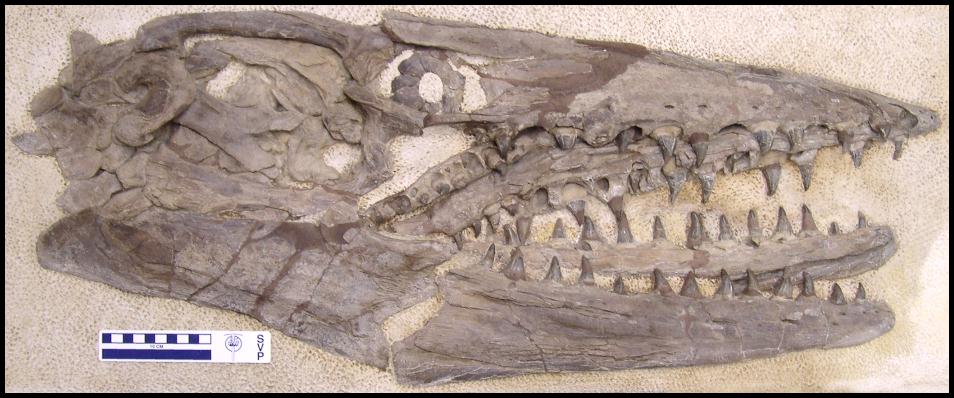
 |
LEFT: The skull of Tylosaurus kansasensis (V-43) in the collection of the Fryxell Museum of Geology, Augustana College, Rockford, IL. Note the bones of the scleral ring. |
Marsh, O. C. 1872. Discovery of the dermal scutes of mosasaurid reptiles.
American Journal of Science, Series 3, 16:290-292.
Wherein O. C. Marsh mistakenly describes the individual elements of the scleral ring around the eye of a mosasaur as 'dermal scutes'. The scleral ring was first noted in mosasaurs by Goldfuss (1845).
| 290 O. C. Marsh ------ Dermal Scutes of
Mosasauroid Reptiles. ART. XXXIX. - Discovery of the Dermal Scutes of Mosasauroid Reptiles; by Professor O. C. MARSH. THE great abundance of Pythonomorpha in the Cretaceous deposits of this country is rapidly affording material for a full understanding of the structure of these peculiar reptiles, about which, until recently, so little has been known. The explorations of the Yale College party in Western Kansas, in 1870, first proved O. C. Marsh - Dermal Scutes of Mosasauroid Reptiles. 291 the existence of posterior limbs, in three of the genera,* and the same party, during their investigations of the past year in that region, have added several other important facts, one of which is, that these reptiles were protected by osseous, dermal plates, a point of much interest in determining their true affinities. An examination of a large number of specimens has shown that this covering existed in Edestosaurus, Liodon, Holcodus and Clidastes, and hence there can be little doubt that it was common to the entire group. The plates were first observed in a specimen of Edestosaurus, on which several were adhering to portions of the skull and lower jaws. A few of these were attached together, apparently in their original position with reference to each other, thus indicating their natural arrangement. There were evidently at least two or three kinds of scutes, and all of those preserved are essentially quadrilateral in form, the posterior margin being the shortest. The lower surface is smooth. The upper side has the margin more or less beveled, to admit an imbricate arrangement when in place, but no true ornamentation. The edges are in general, quite thin, but one shows that it was united by suture. There are also indications of an imperfect articulation, somewhat like that seen in the plates of some species of Palæoniscus. The exact arrangement of the scutes when in place is difficult to ascertain from the limited number of specimens observed, but a complex pattern was evidently produced by alternate rows of scutes of different shape and size. In some places, the edges overlapped in such a way as to bring three thicknesses together. The position in which the plates were found would indicate that they were mainly from the lower part of the neck.
In the genus Liodon, the scutes are also imbricate, and some- what similar to those above described; but all observed appear to be proportionally smaller. Those found with one specimen are quadrilateral in form, with the posterior margin shortest. They are smooth below, but the upper surface is rugose. The exposed portion is linguiform, with its longer axis corresponding to that of the scute. One perfect scute was 26 mm. in length, 20 in average width, and 4.25 in thickness- The scutes in Holcodus, * This Journal, vol. i. p. 447, June, 1871. 292 so far as observed, resemble those of Liodon. In Clidastes, the only scutes detected were some fragments adhering to the caudal vertebræ of C. Wymani Marsh. They are very thin, and quite smooth. The various specimens examined in this investigation render it probable that the cranium of these reptiles was not covered with plates, but the body only, as in some of the Crocodilia. The scutes are apparently different in each species, and hence are important as a means of identification. Yale College, New Haven, March 5th, 1872 . |